Trials 3&4
Result:Getting there!
#3 still way too strong! The brewing time also exceeded 3.5 minutes (closer to 4), which I know isn’t correct. I dumped it and started again (I’m starting to take this personally)…
Okay. Clean slate. Wtf why is this so hard for me? I figured back off to 18g of beans and keep 305ml water (fwiw I don’t actually get 305ml. I seem to lose 10ml or so between the heating and brewing process). I also took apart the 1Zespresso and set it to dead middle for trial 3. The texture was more like a fine powder rather than salt as lawnmower suggested. So for trial 4 I moved it another 3 notches (9 clicks?) towards coarser.
So put the water on (Arrowhead), rinsed the filter with hot tap, and did another grind of 18g of coffee. Btw, this grinder is truly awesome. Even with never having worked any grinder in my life let alone a hand grinder, I can tell how well constructed it is. Takes less than 40 seconds to grind 18g of beans. The consistency was definitely less fine and closer to table salt. I poured it in the V60, set it, and made a divot. Once water was up to temp I started the timer and poured about 40g and let it bloom for 30 seconds. Then I continued in slow concentric swirls but faster this time. When it was almost full, I gently shook the V60, let it go down some, and repeated the process until the water was used up (about 295g total. What happens to the other 10g?)
The total brewing time was just over 3.5 minutes. The coffee was still too strong but after using cream and sugar it was more than 100% improved. For the very first time I tasted the smoothness of the coffee! And the overall taste was deep and rich albeit still too strong for me. I’m hoping my next brew will be much closer to nirvana. Further adjustments I think are needed are:
Still need a coarser grind. I’m gonna go another two settings (6 clicks) towards coarser although that may be a bit too much, but at this point I’d rather err on the side of slightly too weak and adjust from there. I also think a coarser grind will cut down the brew time to within an ideal 3-3.5 minutes. I’m also going to use a bit more water and up it to 310g to start and hopefully wind up with 300g overall for the finished brew
In summary:
I was going too slow on the pour. Once you get all the numbers right, it’s just a nice steady swirling pour. I was babying it too much which resulted in a too long brew time and probably oversaturated grounds
The grind setting was too fine towards an espresso consistency. I think the V60 brew needs a more medium coarseness and my particular taste probably more coarse still. Once I fine tune this enough to where I’m actually enjoying the coffee I’ll try to catch up to all @Lawnmower_Man 's amazing tips and info about water and the rest that is for now, way beyond my ken
Thanks all for the incredibly helpful suggestions. @ripdog that 1Zespresso recommend was spot on!
Edit: I realize I’m now almost at a 17:1 ratio (16.3 if I use the final 295ml after the finished brew), which should be lower strength/higher extraction. I can’t account for this unless I just don’t know the difference between strong and earthy bitter tones that I’m tasting

